For our November lecture GEMMA DAVIES, Director of Economy and Housing for Cheshire West and Chester, gave a talk at the Grosvenor Museum Lecture Theatre. Gemma’s theme was the achievements, future developments and challenges facing the Borough Council. A copy of the presentation can be found by clicking the link below.
Chester Civic Trust Annual Awards for 2026 are now open for nominations:
Chester Civic Trust has responded to the call from Cheshire West and Chester Council for comments around the Local Plan Review. The Government has recently re-introduced mandatory housing targets on local authorities, meaning that Cheshire West and Chester Council is required to demonstrate it can provide for 29,000 new dwellings between 2025 and 2030. This represents a significant increase on the current plan provision.
A link to our submission is here. More information about the Council’s Local Plan Review is here.
Paul Fielding of Lovelock Mitchell spoke on October 8th, on ‘Chester’s other architect; T M Lockwood and Sons and their ongoing architectural legacy.
This lecture explored the architectural legacy of Thomas Meakin Lockwood (1830–1900), a prolific Victorian architect whose work shaped the urban identity of Chester and surrounding regions. It traced his career, family lineage, and the enduring influence of his sons and protégés, culminating in a modern legacy that intersects with planning, civic engagement, and heritage conservation.
Key Highlights were:
- Architectural Impact: Lockwood designed numerous civic, religious, and commercial buildings across Cheshire, Shropshire, and North Wales. His style, rooted in Gothic Revival, contributed significantly to Chester’s visual character.
- Family Legacy: His sons, William and Philip Lockwood, continued the practice, expanding its reach and mentoring future luminaries like Harry Beswick and Maxwell Ayrton (designer of Wembley Stadium).
- Civic Engagement: Lockwood was deeply involved in community institutions, including the Free Library and Freemasonry, reflecting a commitment to public service.
- Cultural Resonance: The lecture includes poignant personal stories, such as the tragic drowning of his daughter Harriette, which humanize the narrative and connect architecture to lived experience.
- Modern Continuity: The firm’s evolution through the 20th century includes collaborations with Patrick Abercrombie, a key figure in British urban planning, and contributions to post-war modernism and civic masterplans.
Strategic Relevance for Business Leaders
- Place Branding: Lockwood’s work offers a foundation for heritage-led regeneration and tourism strategies, especially in Chester.
- Adaptive Reuse Potential: Many surviving buildings present opportunities for sustainable redevelopment aligned with ESG goals.
- Architectural Identity: His legacy supports efforts to preserve regional character amid modern development pressures.
- Talent Development: The mentorship lineage from Lockwood to Ayrton and Abercrombie illustrates the value of long-term investment in architectural education and innovation.
The lecture took place in the packed Grosvenor Museum Lecture Theatre.
Civic Trust members have FREE admission to the lecture series at the Grosvenor Museum. Guests are always welcome £5 on the door.
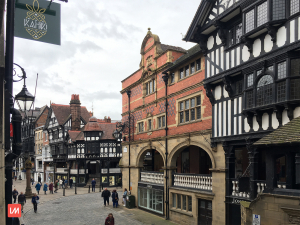
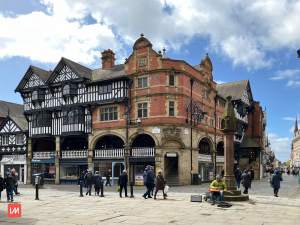
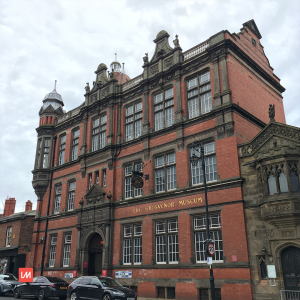
The sun shone on the Chester Civic Trust walk, guided by David Mottram, exploring the Old Ferry Terminal and Victorian Pleasure Gardens of Eastham.
David brought back to life the wonders that must have greeted the visitors when they entered The Gardens through an arch constructed to commemorate Queen Victoria’s Diamond Jubilee.
The gardens contained colourful raised flower beds with exotic trees and shrubs, five fountains , a boating lake and a performance area where the famous tightrope walker Chevalier Blondin performed in 1883.
In addition from 1860 to 1890 a zoo including lions, bears , seals and monkeys existed.
Later additions included a water shoot, think steam-powered log flume and even a loop-the-loop railway, an early ‘Alton Towers type’ corkscrew.
It is hard to imagine now in this beautiful and tranquil park the excitement that lay within.
Thank you to David for this fascinating insight into the Park’s past.
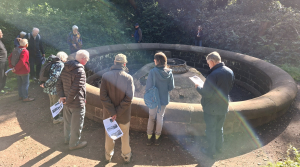
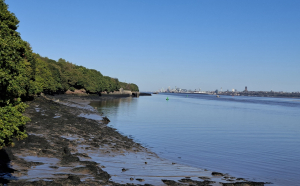
Have you ever walked down Water Street and wondered about the history of the façades on some of the amazing buildings? The façade of probably the most interesting of all these buildings, Bishop Lloyd’s Palace, was the subject of a talk at Chester Civic Trust by Karen Mc Kay on Friday 22 August.
In a talk that Karen made both entertaining and interesting, we learned about the earliest carvings on the façade of this Grade one listed building. The carvings cannot be seen clearly from street level but with the help of drone photography from Skysnapper Aerial Photography these early 17th carvings, influenced by the Merchant Adventurers who occupied this site at the time, can be seen clearly despite hundreds of years of exposure to the elements.
Karen explained the differing architectural styles and the influence of the interest in travel and fantastical creatures prevalent at that time. She brought these wonderful carvings to life.
The World of Glass at St Helens is built around the 1877 Tank House where William Windle Pilkington perfected the regenerative process of continuous glass making. As well as a view of how glass was made, there is a museum of glass from its origins to contemporary glass making.
The private guided tour included glass blowing, the museum galleries, the tank house and the tunnels. Refreshments on arrival and the sandwich and quiche lunch were excellent.
Astley Hall in Chorley dates from 1570, with improvements throughout its history. It is Grade 1 Listed, with huge mullioned and transomed external bay windows and an intriguing collection of painted notables on panels in the Hall. Its real delight is its exquisite plaster-work ceilings, which are truly astounding. The private guided tour allowed time to walk in the grounds and visit Café Ambio in the stables.
Report and photos thanks to Karen McKay.
Photos LtoR: 1960 chandelier previously in Manchester airport, Exhibits including an Emile Galle vase, and the Merchant Adventurers coat of arms in stained glass.
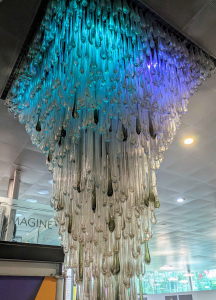
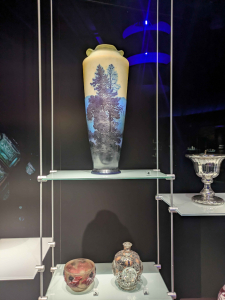
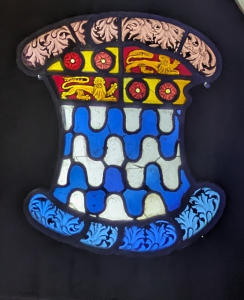
Michael Emery gave an excellent talk on local archaeology so we are fully up to date.
Mike has worked at over 150 archaeological sites in the UK on a wide variety of community, research and commercial projects. He was instrumental in setting up the Poulton Research Project which he led for 21 years.
He is co-director of Chapel Archaeology CIC (Community Interest Company) and will describe the company’s research over the last nine years, which has included a study of rural and urban
ecclesiastical landscapes in Chester and south-west Cheshire. Mike will be joined by local historian Carolyn Barnwell, also a co-director of Chapel Archaeology.
Heritage Lottery funding enabled an in-depth study of the village of Shocklach and its environs, including its isolated church, and led to the publication of two books.
A recent ongoing project at St. John’s Church, Chester, has included internal surveys, external geophysical investigations and analysis of the church archives and is producing fascinating
results.
Wine and nibbles were served after the talk on June 10th at Bishop Lloyd’s Palace at 7.30pm.
His Royal Highness The Duke of Gloucester visited Chester Civic Trust at Bishop Lloyd’s Palace (BLP) in May.
Personnel from the Trust were on hand to guide the Duke through the displays, exhibits and discuss Chester Civic Trust’s work and role.
The discussions related to his previous visit to Chester in 1975 in European Architectural Heritage Year, 50 years ago, when Chester played such a significant role.
In a letter sent to BLP after the visit, His Royal Highness “enjoyed viewing the exhibition on the Trust’s sixty fifth anniversary and the European Architectural Heritage Year fiftieth anniversary and was pleased to meet so many enthusiastic and friendly trustees”. The letter added; “Warmest regards and wishes for the future.”
More information on the European Architectural Heritage Year celebrations is at https://cheshirehistoricbuildings.org/news/
Photos: (Top) Duke of Gloucester with David Evans Vice Chair & Christine Russell Chair of Chester Civic Trust.
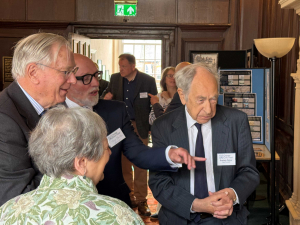
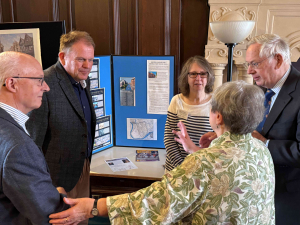


The Duke of Gloucester reviewing European Architectural Heritage Year progress in 50 years, with John Herson Graham & Sarah Caitlin discussing waterways, with John Tweed and Christine Russell and arriving at Bishop Lloyd’s Palace. Photos: Marketing PRojects.


